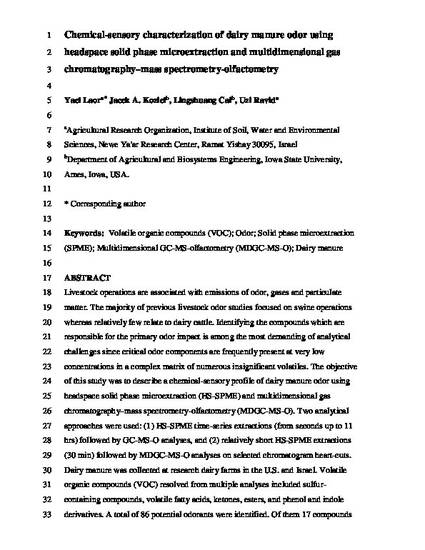
Livestock operations are associated with emissions of odor, gases, and particulate matter. The majority of previous livestock odor studies focused on swine operations whereas relatively few relate to dairy cattle. Identifying the compounds responsible for the primary odor impact is a demanding analytical challenge because many critical odor components are frequently present at very low concentrations within a complex matrix of numerous insignificant volatiles. The objective of this study was to describe a chemical-sensory profile of dairy manure odor using headspace solid-phase microextraction (HS-SPME) and multidimensional gas chromatography-mass spectrometry-olfactometry (MDGC-MS-O). Two analytical approaches were used: (1) HS-SPME time-series extractions (from seconds up to 20 hr) followed by gas chromatography-mass spectrometry-olfactometry (GC-MS-O) analyses, and (2) relatively short HS-SPME extractions (30 min) followed by MDGC-MS-O analyses on selected chromatogram heart-cuts. Dairy manure was collected at research dairy farms in the United States and Israel. Volatile organic compounds (VOCs) resolved from multiple analyses included sulfur-containing compounds, volatile fatty acids, ketones, esters, and phenol/indole derivatives. A total of 86 potential odorants were identified. Of them, 17 compounds were detected by the human nose only. A greater number of VOCs and odorous compounds were detected, as well as higher mass loading, on solid-phase microextraction (SPME) fibers observed for longer extractions with SPME. However, besides sulfur-containing compounds, other selected compounds showed no apparent competition and displacement on the SPME fiber. The use of MDGC-MS-O increased chromatographic resolution even at relatively short extractions and revealed 22 additional odorants in one of the regions of the chromatogram. The two analytical approaches were found to be parallel to some extent whereas MDGC-MS-O can also be considered as a complementary approach by resolving more detailed chemical-sensory odor profiles.
Available at: http://works.bepress.com/jacek_koziel/175/

This is an Accepted Manuscript of an article published by Taylor & Francis as Laor, Yael, Jacek A. Koziel, Lingshuang Cai, and Uzi Ravid. "Chemical-sensory characterization of dairy manure odor using headspace solid-phase microextraction and multidimensional gas chromatography mass spectrometry-olfactometry." Journal of the Air & Waste Management Association 58, no. 9 (2008): 1187-1197. Available online DOI: 10.3155/1047-3289.58.9.1187. Posted with permission.